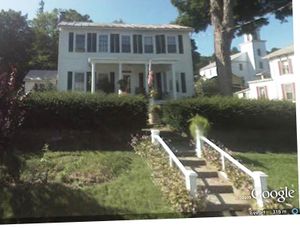Charles E. Deitz House
Charles E. Deitz House
1659 Helderberg Trail
- 1855 there was an old wooden frame house at 1659 Helderberg Trail. It was owned by Abram Ball (1809 - after 1880) who was a tailor.
- <1860 Abram Ball had the old frame house torn down and built what was called a gravel house, now it would be called a concrete house. They were popular at the time
- 1865 there were eight gravel houses in the Town of Berne.
- 10 Sep. 1867 Abram Ball and his wife sold the property to Charles E. Deitz. Next door to the east was the house of William Henry Ball, brother of Abram.
- 1875 when William died his son William Minor Ball inherited the house.
- 18 April 1878 he sold part of the property to Charles E. Deitz.
- 1880 is when tax records say that the present house. Assuming that is correct, it would have been built by Charles E. Deitz. It is possible that Abram Ball's concrete house stood further back in line with the Reformed Church and that the Charles E. Deitz House was built in front of it.
According to Our Heritage, Charles E. Deitz (1840 – 1920) was a prominent merchant in Berne for many years and sold an unbelievable variety of merchandise. In 1873 he purchased the store where the old post office used to be, just up from what was then Settle’s store. He was the Justice of the Peace and a postmaster until 1897. Charles Deitz was deeply interested in religion and his sons Archibald and Raymond became ministers.
- < 1920 following the death of Charles Deitz his wife continued to live in the house until she died in 1924.
- 1924 the house went to their daughter Leona Deitz.
- 20 June 1925 Leona Deitz sold the house to Austin Mattice.
Austin Mattice (1867 - 1958) owned and managed a hotel in 1920, presumably the one where the Town Hall is now located, and presumably lived there. Evidently he sold the hotel about 1925 and bought the Deitz house. In 1925 he was working on the State Road. By 1930 he was a Deputy Sheriff of Albany County. In
- 1942 his wife died and he sold the house to Donald Boyden, a teacher at of agriculture and shop at the Berne-Knox-Westerlo school. At the time it was a two family house.
